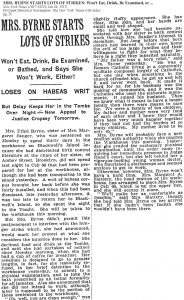Oct 18, 2016

New York Times, January 24, 1917
On October 16th, Planned Parenthood of New York reached its 100th anniversary. It grew from a small birth control clinic created in Brownsville, Brooklyn by Margaret Sanger, her sister Ethel Byrne, and Fania Mindell. At the clinic, they distributed birth control, as well as pregnancy planning advice and information. Even though the three women were arrested for distributing obscene material and jailed, their efforts led to changes in the law allowing for birth control and sex education in the years to come. In 1921, the clinic became the American Birth Control League, which changed its name to the Planned Parenthood Federation of America in 1942.
What does this have to do with Mount Sinai? Margaret Sanger and her younger sister, Ethel Byrne, were nurses. Mrs. Byrne graduated from The Mount Sinai Training School for Nurses in 1909. The sisters did not always get along, but they were united in the believe of women having the right to plan their families. Mrs. Byrne protested her sentence and her jail term of 30 days and launched a hunger strike, which brought a great deal of attention to their cause. The hunger strike lasted for five days, and then she was forcibly fed by prison doctors. Mrs. Sanger and women civic leaders, including Anne Van Kirk, the Superintendent of The Mount Sinai Hospital Training School, appealed for her release. The Governor granted the request on February 1st when Sanger promised that her sister would never break the Comstock law again. Byrne was taken to her sister’s house for care, but this episode damaged their relationship. Byrne did not actively participate in the birth control movement after this.
Ethel Byrne’s later years were quiet. She moved to Massachusetts and returned to nursing. She died in 1955. In 1962, Alan F. Guttmacher, MD left his post as Chairman of OB-GYN at The Mount Sinai Medical Center to become the President of Planned Parenthood. The Mount Sinai connection continued.
Oct 7, 2016

(Click to expand the image)
Sixty years ago this month, The Mount Sinai Hospital said goodbye to the last of a group of 25 women from Hiroshima, Japan who had spent over a year at the Hospital having surgeries to repair injuries they suffered in the nuclear blasts that ended World War II. The group of young women were called the Hiroshima
Maidens, and the project that brought them from Japan to the U.S. was the brainchild of Norman Cousins, the Editor of the Saturday Review of Literature. He raised the funds needed for the project and enlisted the help of the Quaker community of the metropolitan New York region to house the Maidens when they were not in the Hospital. Three surgeons from The Mount Sinai Hospital volunteered their time (Drs. Arthur Barsky, Bernard Simon and Sidney Kahn), and the President of the Hospital, Alfred Rose, anonymously paid for the use of four hospital beds for the duration of the project.
The Hiroshima Maidens project was a milestone in postwar American-Japanese relations. Before leaving Japan, the girls were told by some that the American doctors were going to experiment on them. As it became clear that this was not the case, the donated funds were stretched to allow Japanese doctors to come to Mount Sinai and receive training in plastic and reconstructive surgery, thus helping to strengthen the field in Japan.
The Hiroshima Maidens project continued to have life. In 1995, one of the Maidens returned to Mount Sinai to meet with Dr. Simon. At that time she gave the Mount Sinai Archives a scrapbook of photocopies of images from Hiroshima after the blast. The next year there was a conference at Mount Sinai that celebrated the project from 40 years before, and highlighted Mount Sinai’s current international efforts. In spring 2005, for the 50th anniversary of the project, the last remaining Maiden and a group of Japanese press visited Mount Sinai once again. The group came to the Archives and looked at the photos from the 1950s and read again the newspaper accounts of the Maidens’ courageous journey to New York.
On this 60th anniversary, it is unknown if any Maidens are still alive. Still, it is comforting to know that the memory – and documentation – of the project lives on, and will not be forgotten.


